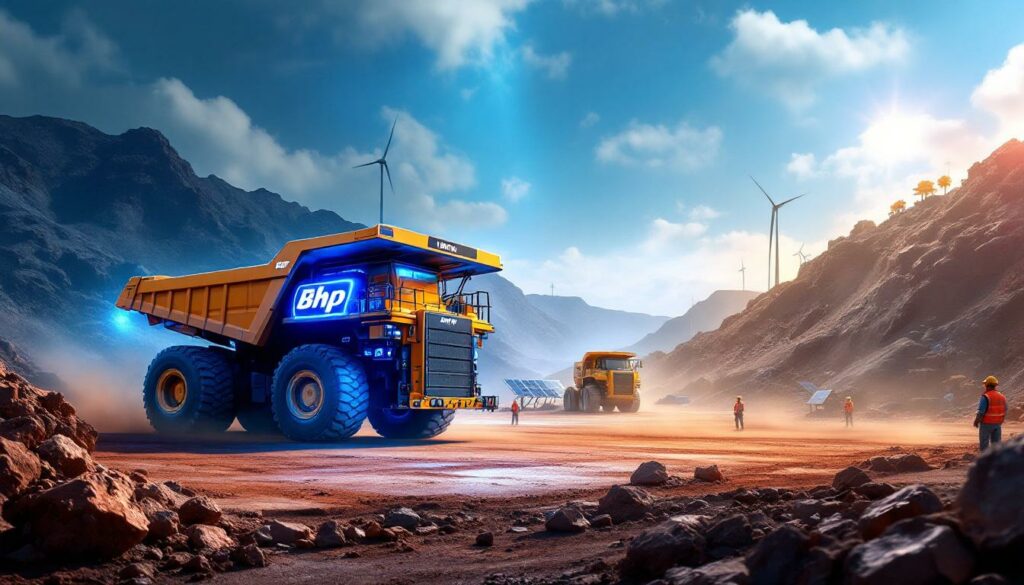How Is BHP Partnering With Battery Companies to Achieve Decarbonization Goals?
BHP has taken a significant step toward its climate targets by forging strategic partnerships with two of the world's leading battery manufacturers. In July 2025, the mining giant signed memoranda of understanding (MoUs) with FinDreams Battery (FDB), a subsidiary of BYD Group, and Contemporary Amperex Technology Co. Limited (CATL). These collaborations aim to revolutionize mining operations through cutting-edge battery technologies specifically designed for the unique challenges of resource extraction.
The partnerships represent a fundamental shift in how mining companies approach decarbonization—by working directly with battery technology innovators rather than equipment manufacturers, BHP gains access to customized solutions that address the specific power requirements and environmental conditions of mining operations.
As Rashpal Bhatti, BHP Group Procurement Officer, explained: "This relationship is a further step towards BHP meeting our decarbonisation ambitions for our operations and helping to drive transformative change within the global resources industry." This sentiment was echoed by Jack Li, FDB General Manager of the Global Commercial Vehicle Business Unit, who called the MoU a "pivotal milestone" and recognized BHP as "a true industry leader, with an aspirational vision to achieve net-zero operational greenhouse gas emissions."
The partnerships focus on developing specialized battery solutions for heavy mining equipment, locomotives, flash-charging infrastructure, and exploring electric vehicle integration in mining contexts—all critical components in transitioning away from diesel-dependent operations.
BHP's Decarbonization Strategy and Net-Zero Commitments
The Path to Net-Zero Emissions
BHP has established one of the mining industry's most ambitious climate targets: achieving net-zero operational greenhouse gas emissions (Scopes 1 and 2 from operated assets) by 2050. This commitment represents a profound transformation for a company whose operations span continents and traditionally rely heavily on fossil fuels for everything from haul trucks to power generation.
The mining giant's decarbonization roadmap involves a multi-faceted approach including operational efficiency improvements, renewable energy procurement, and perhaps most critically, the electrification of its vehicle fleet and equipment. These battery partnerships represent a cornerstone of this strategy, targeting one of the most challenging aspects of mining decarbonization—mobile equipment that operates continuously in remote and harsh environments.
Why Battery Technology Is Critical for Mining Decarbonization
The mining sector faces unique challenges in its decarbonization journey. Unlike many industries, mining operations often take place in remote locations with extreme conditions, require continuous 24/7 operations, and utilize equipment with extraordinary power demands. Diesel fuel has traditionally been the energy source of choice due to its energy density, portability, and reliability.
However, diesel-powered equipment is a major contributor to mining's carbon footprint. A typical large haul truck can consume hundreds of liters of diesel per day, resulting in significant greenhouse gas emissions. Battery technology offers a viable pathway to reduce these emissions while maintaining—or even enhancing—operational efficiency.
The electrification of heavy mining equipment represents what industry experts call the "final frontier" of mining decarbonization. While stationary infrastructure can be powered by renewable energy through grid connections or on-site generation, mobile equipment requires portable power solutions with sufficient energy density and durability to withstand harsh mining conditions.
What Does the BHP-FinDreams Battery Partnership Involve?
Key Focus Areas of the Collaboration
The partnership between BHP and FinDreams Battery (FDB) focuses on several strategic initiatives that target core operational challenges:
-
Heavy Mining Equipment Battery Solutions: Developing battery systems capable of powering massive mining vehicles that traditionally consume vast quantities of diesel fuel. This includes haul trucks, excavators, and loaders that form the backbone of mining operations.
-
Mining Locomotive Applications: Creating electric power systems for the rail networks that transport ore and materials within mining complexes and to port facilities.
-
Flash-Charging Infrastructure Development: Implementing rapid recharging systems that minimize operational downtime—a critical factor in maintaining mining productivity. Flash-charging technology allows for ultra-fast power transfer during brief operational pauses.
-
Electric Vehicle Integration: Exploring how BYD's commercial and light electric vehicles can be adapted and deployed across mining sites for personnel transport and auxiliary operations.
Strategic Benefits for Both Companies
For BHP, this partnership provides access to FDB's industry-leading battery technology and manufacturing expertise. As Rashpal Bhatti noted, "BYD is a leader in their field and at the cutting-edge of what's possible in battery technology and advanced manufacturing." This collaboration gives BHP a competitive advantage in developing mining-specific battery solutions.
For FinDreams Battery, the partnership offers an opportunity to expand into the high-demand, specialized mining sector—a market with unique requirements and substantial growth potential as the industry transitions to electrified operations. It also provides FDB with real-world testing environments where their technology can be pushed to its limits and refined for the most demanding applications.
The collaboration aims to create tailored solutions for mining environments that go beyond simply adapting existing battery technologies. By developing purpose-built systems, the partnership seeks to address the specific weight-to-power ratios, durability requirements, and safety considerations unique to mining applications.
How Will the BHP-CATL Partnership Advance Mining Sustainability?
Collaborative Focus Areas
BHP's memorandum of understanding with Contemporary Amperex Technology Co. Limited (CATL) encompasses four key areas of collaboration:
-
Mining Equipment Electrification: Developing battery systems specifically designed for the operational demands of mining equipment, with a focus on performance in extreme environments.
-
Energy Storage Systems: Creating large-scale battery storage solutions to support mining operations, particularly in remote locations where grid reliability is a concern or where renewable energy integration requires storage capacity.
-
Circular Economy Initiatives: Establishing battery recycling breakthrough programs and sustainable lifecycle management to minimize environmental impact and recover valuable materials. This includes protocols for repurposing batteries that no longer meet mining specifications but retain sufficient capacity for less demanding applications.
-
Supply Chain Integration: Exploring synergies between BHP's copper supply integration and CATL's battery manufacturing operations to create more sustainable and resilient supply chains.
The Copper Connection
One of the most innovative aspects of the BHP-CATL partnership is the potential integration with BHP's copper operations. Copper is a critical material for battery manufacturing and electrical infrastructure, with demand expected to surge as global electrification accelerates.
As one of the world's largest copper producers, BHP is well-positioned to supply this essential material directly to battery manufacturers like CATL. This vertical integration opportunity represents a unique advantage that few mining companies can offer.
The partnership creates potential for what industry analysts call a "mine-to-battery" supply chain, where copper extracted from BHP operations could be tracked, traced, and certified as responsibly produced before entering CATL's manufacturing processes. This would allow both companies to offer batteries with transparent provenance and demonstrated ESG (Environmental, Social, and Governance) credentials—increasingly important factors for end-users in automotive and energy storage markets.
"CATL is a global leader in new energy innovative technologies and is a natural partner for BHP," said Rashpal Bhatti. "Together, we will explore opportunities to support the electrification of mining equipment through battery technology."
What Are the Industry Implications of These Partnerships?
Setting New Standards for Mining Decarbonization
These collaborations represent a significant shift in how mining companies approach decarbonization. By partnering directly with battery technology leaders, BHP is positioning itself at the forefront of mining electrification and sustainable operations.
Traditional approaches to equipment innovation in mining have typically involved Original Equipment Manufacturers (OEMs) developing new products with incremental improvements. BHP's strategy of going directly to battery technology specialists represents a more aggressive approach that could accelerate the pace of change.
This model of collaboration—bringing together resource producers and technology innovators—may become the new standard for how mining companies approach their energy transition. It acknowledges that the technical challenges of mining electrification require specialized expertise that goes beyond traditional mining innovation trends.
Potential Ripple Effects Across the Resources Sector
As one of the world's largest mining companies, BHP's investments in battery technology will likely have industry-wide impacts:
-
Accelerated Technology Development: BHP's scale and resources will help drive rapid advances in mining-specific battery solutions that could benefit the entire sector.
-
Supply Chain Transformation: These partnerships may reshape how mining companies think about vertical integration, particularly regarding critical minerals transition and battery manufacturing.
-
New Industry Standards: Solutions developed through these collaborations could establish new benchmarks for equipment performance, safety protocols, and sustainability metrics.
-
Competitive Pressure: Other major mining companies may feel compelled to form similar partnerships to avoid technological disadvantage in an increasingly carbon-constrained operating environment.
-
Skills Development: The industry will need to develop new expertise in electrical systems, battery management, and related technologies, potentially creating new career paths within mining.
The partnerships also signal to investors, regulators, and communities that electrification is not merely a theoretical future state for mining but a concrete direction with major corporate backing. This could influence financing decisions, regulatory frameworks, and community expectations across the resources sector.
What Challenges Must Be Overcome for Successful Implementation?
Technical Hurdles in Mining Electrification
Despite the promising potential, mining electrification faces substantial technical challenges that must be addressed for successful implementation:
-
Extreme Operating Conditions: Mining environments subject equipment to punishing conditions including temperature extremes (-40°C to +50°C), high humidity, corrosive dust, constant vibration, and impact stresses. Battery systems must maintain performance and safety across these conditions.
-
High Power Requirements: Mining equipment often requires extraordinary power outputs. A single ultra-class haul truck can demand peak power equivalent to hundreds of passenger electric vehicles. Battery systems must deliver this power while managing thermal loads and maintaining cell stability.
-
Remote Locations: Many mines operate in isolated areas with limited or no grid connectivity. Battery solutions must function reliably without the support infrastructure available in urban environments.
-
Operational Continuity: Mining typically operates continuously, 24/7/365. Battery systems need to support this operational model through rapid charging, battery swapping, or other innovations that minimize downtime.
-
Safety Considerations: The mining environment presents unique safety challenges for battery systems, including potential exposure to blasting vibrations, rock falls, and collisions. Battery technologies must incorporate robust safety features beyond those required in consumer applications.
Infrastructure Development Requirements
Beyond the battery technology itself, successful implementation will require significant investments in supporting infrastructure:
-
Charging Infrastructure: Mines will need extensive charging networks capable of delivering megawatts of power to multiple vehicles simultaneously. This includes both standard charging for overnight/shift change periods and flash-charging stations for opportunity charging during operational pauses.
-
Power Distribution Systems: Mine electrical systems were typically not designed to handle the load profiles created by battery charging. Substantial upgrades to switchgear, transformers, and distribution networks will be necessary.
-
Renewable Energy Integration: To maximize emissions reduction, many mines will need to couple electrification with renewable energy generation. This creates additional complexity in balancing intermittent generation with operational power demands.
-
Maintenance Facilities: New workshop facilities with specialized equipment and safety systems will be required for battery maintenance, testing, and repair.
-
Digital Infrastructure: Advanced energy management systems, predictive maintenance platforms, and fleet optimization software will be essential to maximize the benefits of electrified equipment.
These infrastructure investments represent significant capital expenditures that mining companies must factor into their electrification strategies. The partnerships with FDB and CATL may help BHP identify cost-effective approaches to these challenges by leveraging the battery companies' experience in other sectors.
How Do These Partnerships Support BHP's Broader Sustainability Goals?
Alignment with ESG Commitments
These battery partnerships directly support BHP's environmental, social, and governance (ESG) commitments in several key areas:
-
Carbon Reduction: Electrification directly addresses Scope 1 emissions from diesel combustion in mobile equipment, a significant portion of BHP's operational carbon footprint.
-
Air Quality Improvement: Battery-electric equipment eliminates the particulate matter, nitrogen oxides, and other pollutants associated with diesel engines, creating healthier working environments and reducing impact on surrounding communities.
-
Noise Reduction: Electric motors operate significantly more quietly than internal combustion engines, reducing noise pollution both for workers and neighboring communities.
-
Water Conservation: Unlike fossil fuel value chains, battery-electric systems do not require water for extraction, refining, or combustion processes, supporting BHP's water stewardship goals.
-
Waste Reduction: The circular economy initiatives with CATL aim to minimize waste through battery recycling and repurposing, aligning with BHP's resource efficiency objectives.
These improvements support BHP's social license to operate by demonstrating tangible environmental benefits to communities, regulators, and investors increasingly focused on sustainable mining practices.
Creating a More Sustainable Mining Model
By investing in battery technology and electrification, BHP teams up with battery giants to drive decarbonisation in a way that fundamentally changes how mining operations are powered and conducted.
This transition represents more than just swapping diesel engines for batteries—it enables a rethinking of mine design, operations, and energy systems. For example, electric equipment can potentially operate in underground environments with minimal ventilation requirements, creating opportunities for new mining methods and approaches.
The partnerships also position BHP to contribute to the broader energy transition beyond its own operations. By helping develop mining-specific battery solutions, BHP is supporting technologies that will be essential for global decarbonization across sectors, creating positive impact that extends far beyond its operational boundaries.
What Is the Timeline for Implementation?
Near-Term Objectives
While specific timelines haven't been disclosed, these partnerships likely involve phased implementation:
-
Research and Development Phase (1-2 years): Initial collaboration on technical specifications, prototype development, and laboratory testing of battery systems designed for mining applications.
-
Pilot Testing (2-3 years): Deployment of prototype battery solutions in controlled mining environments to evaluate performance, reliability, and maintenance requirements under real-world conditions.
-
Limited Operational Deployment (3-5 years): Implementation of successful technologies at selected mining operations, with ongoing refinement based on operational feedback.
-
Fleet-Wide Scaling (5+ years): Broader deployment across BHP's global portfolio as technologies mature and supporting infrastructure is developed.
This phased approach allows for technological learning, cost optimization, and infrastructure development to occur in parallel, reducing implementation risks while maintaining progress toward decarbonization goals.
Long-Term Vision for Mining Electrification
The partnerships represent a long-term commitment to transforming BHP's operations, with full implementation likely extending over the coming decade. This timeline aligns with the company's 2050 net-zero target, providing sufficient time for technology maturation and capital investment cycles.
The long-term vision likely includes:
- Complete electrification of certain mine sites selected as "flagship" low-carbon operations
- Integration of battery storage with renewable energy generation to create semi-autonomous energy systems at remote locations
- Development of second-life applications for mining batteries as they reach end-of-first-life but retain useful capacity
- Establishment of closed-loop material recovery systems for battery components
As these partnerships mature, the knowledge and technologies developed will likely be transferred across BHP's global operations, with implementation timelines varying based on mine-specific factors including remaining asset life, infrastructure readiness, and local energy context.
How Do These Partnerships Compare to Other Mining Industry Initiatives?
Industry Context for Battery Adoption
BHP's partnerships with FDB and CATL position the company among the leaders in mining electrification, though it is not alone in exploring this frontier. Other major mining companies have launched various initiatives:
- Several mining companies have tested battery-electric underground equipment where ventilation savings provide immediate operational benefits
- Some operations have implemented trolley-assist systems for haul trucks, using overhead electrical lines on main haulage routes
- Various pilot projects have tested battery-electric light vehicles and support equipment in mining environments
However, BHP's comprehensive partnerships with battery technology leaders represent a more significant commitment than many previous initiatives. Rather than simply purchasing available electric equipment, BHP is helping shape the development of mining-specific battery solutions from the ground up.
Competitive Advantages of BHP's Approach
By partnering directly with battery manufacturers rather than equipment providers, BHP gains several potential advantages:
-
Customized Solutions: Direct collaboration with battery innovators allows for mining-specific optimization rather than adapting automotive or industrial batteries to mining applications.
-
Intellectual Property Development: Joint R&D efforts may generate valuable intellectual property that gives BHP competitive advantages in operational efficiency and emissions reduction.
-
Supply Chain Security: Closer relationships with battery manufacturers potentially provide more reliable access to battery materials and components as global demand increases.
-
Accelerated Learning: Direct engagement with battery technology experts accelerates BHP's internal knowledge development, building organizational capabilities that will be increasingly valuable as electrification advances.
-
First-Mover Opportunities: By helping develop mining-specific solutions, BHP positions itself to influence industry standards and potentially commercialize technologies developed through these partnerships.
These advantages could create meaningful operational and competitive differentiation as the mining industry transitions toward electrified operations. The partnerships demonstrate BHP's willingness to invest in transformation rather than incremental change—a strategic approach that may yield significant long-term benefits as [BHP and Rio T
Ready to Catch the Next Major Mineral Discovery?
Don't miss potential market-moving announcements with Discovery Alert's proprietary Discovery IQ model, delivering instant notifications on significant ASX mineral discoveries directly to your inbox. Explore why major discoveries can lead to exceptional returns by visiting our dedicated discoveries page and begin your 30-day free trial today.




